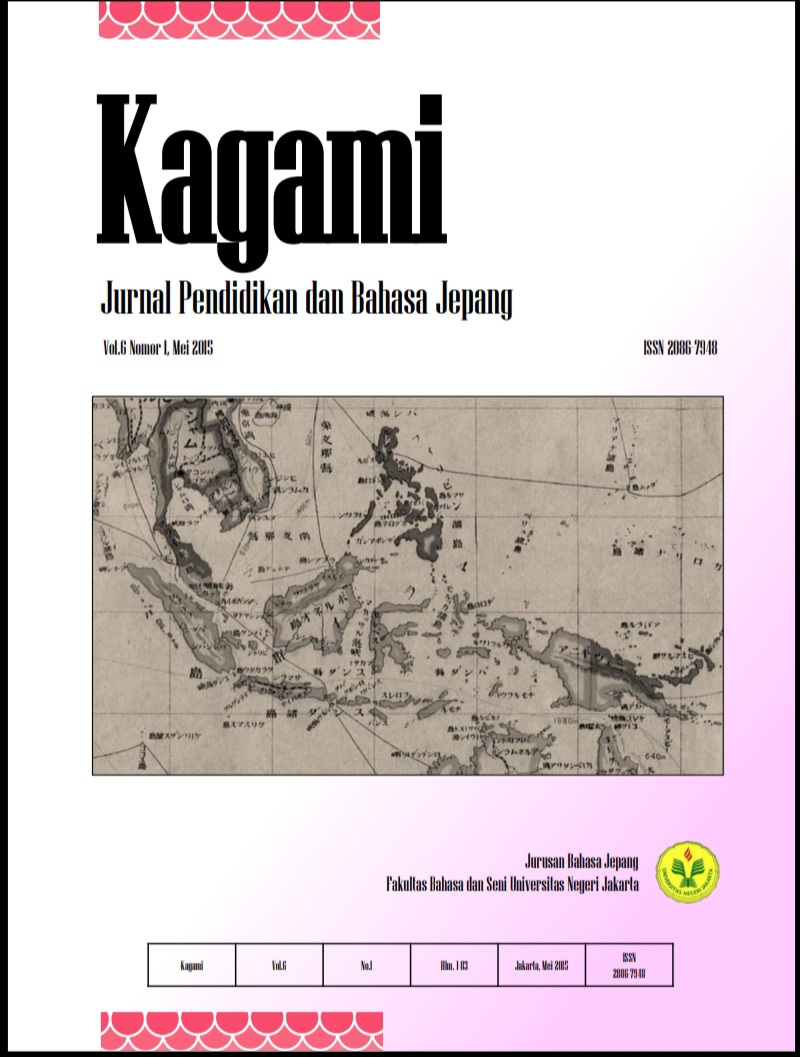EFEKTIFITAS MODEL COOPERATIVE LEARNING TEKNIK JIGSAW DALAM PEMBELAJARAN DOKKAI II
Abstract
This research is an experiment research for study model in jigsaw co-operative
learning effectivity. The sample research is second grade academic years
2013/2014 students in dokkai II subject. Based on the result, gaining the average
of study result in post test with the average value is 7,65 point at experiment class
and 8,26 point at control class. therefore is 0,86 point. Moreover, is
smaller than , so Hk is unaccepted. Thus, in dokkai II subject was
uneffective on co-operative learning in jigsaw method. Because the students
attend three classes before dokkai II class from 14.20, students feel saturated,
worn out and unconcentration. wherefor those few factor comprehensive analysis
is too less on expert group student, random group student can’t explained crearly
on their own group. Furthermore, the control class teacher always use discourse
lecture, the students are accustomed to a class like that. Then study method in that
control class is reading together and interpreting each sentences of the reading
contents. wherefore, student’s mind set is equal and unattracted of some debate,
and then students understand more about the reading contents, discussing together
directly.
References
challenges.[e-book].Tersedia:
http://books.google.com/books?isbn=1604560606. [28 Mei 2014].
Gillies, Robyn M., Ashman, Adrian., Terwel, Jan. (2007). The Teacher’s Role in
Implementing Cooperative Learning in the Classroom. [e-book]. Tersedia :
http://books.google.com/books?isbn=0387708928. [21 Mei 2014].
Glasgow, Neal A., & Hicks, Cathy D. (2004). What Successful Teacher To Do :
101 Research-based Classroom Strategies for New & Veteran Teachers. [e-
book]. Tersedia : http://books.google.com/books?isbn=1452272425. [21
Mei 2014].
Imai, Hiroyuki. (2011). “Kyoudou Gakushuu no Susume: Eigo no Jyugyou ni
motto Kyoudou Gakushuu wo”. Teaching English Now. Vol. 20, Hal. 21.
Iru, La., Arihi, Safiun. (2012). Analisis Penerapan Pendekatan, Metode, Strategi,
dan Model-Model Pembelajaran. Yogyakarta: Multi Presindo.
Ishikawa, Kiyohide., Ishida, Yuki. (2013). Kyoudou Gakushuu Tsu-ru no
Tsukurikata Ikashikata. Tokyo: Kabushiki Gaisha Nakanisha Shuppan.
Jacob, Evelyn. (1999). Cooperative Learning in Context: An Educational
Innovation in Everyday Classrooms. [e-book].
Tersedia : http://books.google.com/books?isbn=0791442411. [28 Mei 2014].
Jill,Parker. (2012). “Jigsaw Strategy Sheet #3”. http:// Ejlazaros.iweb.bsu.edu/
itedu691/pdf/jigsaw.pdf. [29 Mei 2014].
Jiro,Abe. (2011). http:// www.hak.hokkyodai.ac.jp /~f-chug-m /H10STUDY/
h10gijyu.pdf. [28 Mei 2014].
Lie, Anita. (2002). Cooperative Learning : Mempraktikkan Cooperative Learning
di Ruang-Ruang Kelas. Jakarta: PT. Grasindo.
Nara, Hartini., Siregar, Eveline. (2010). Teori Belajar dan Pembelajaran. Bogor :
Ghalia Indonesia.
Orlich, D. (2007). Teaching Strategies : a guide to effective instruction.Cengange
Learning.
Richards, Jack., Rodgers, Theodore. (2001). Approaches and Methods in
Language Teaching. United Kingdom: The Press Syndicate of the
University of Cambridge.
Sugie, Shuji. (2011). Kyoudou Gakushuu Nyuumon: An Invitation to Cooperative
Learning. Tokyo: Kabushiki Gaisha Nakanisha Shuppan.




